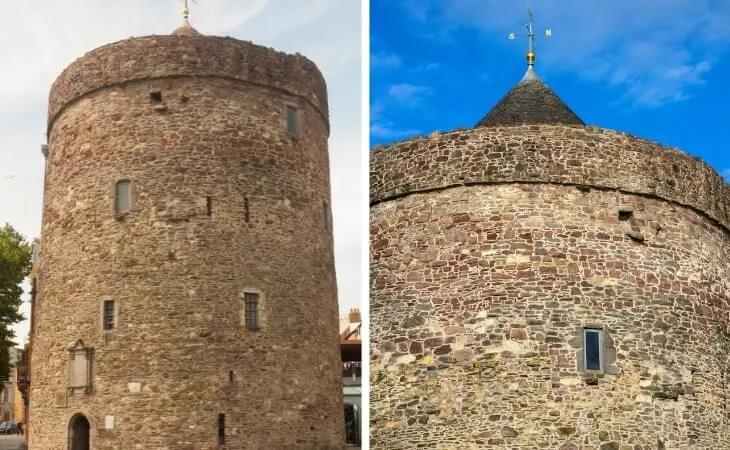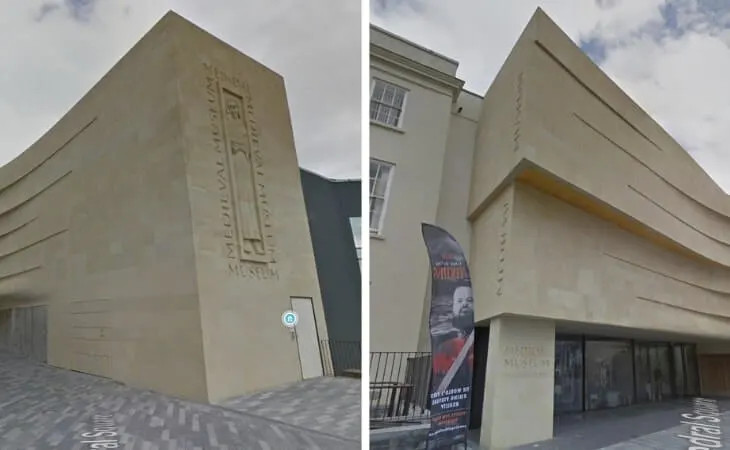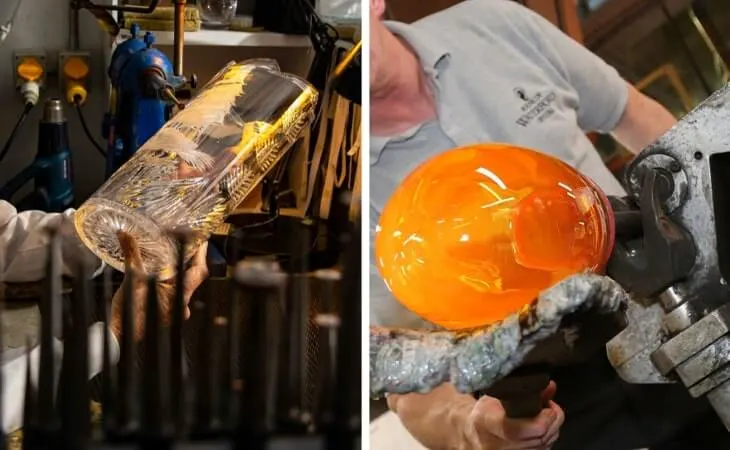The historic Reginald’s Tower is a landmark in Waterford City and it’s one of the better-known sites in Waterford’s Viking Triangle.
This medieval round tower is the oldest civic building in the city and the only monument in Ireland to retain a Viking name.
Standing 16m high, it has had various uses. It is now a Viking museum crammed with interesting exhibits and artifacts.
In the guide below, you’ll discover everything from opening hours and admission to what to see inside Reginald’s Tower in Waterford.
Some quick need-to-knows before visiting Reginald’s Tower in Waterford

Photo via Google Maps
Although a visit to Reginald’s Tower in Waterford is fairly straightforward, there are a few need-to-knows that’ll make your visit that bit more enjoyable.
1. Location
Reginald’s Tower stand in the historic Viking Triangle of Waterford City. It is located at the east end of Parade Quay overlooking the waterfront. It’s easy to spot, opposite the Visitor Information Centre and close to the House of Waterford Crystal. Parking is available on the Quays, the Mall and Bolton Street car park.
2. Admission and opening hours
Adult admission is €5 with special rates for seniors, children and families. Opening hours from late March to mid-December are daily from 9:30 to 17:30. From January through early March it opens Wednesday-Sunday from 9:30 to 17:30. Last admissions are 30 minutes before closing (prices may change).
3. Home to the Waterford Viking Museum
Reginald’s Tower is one of three museums in the Viking Triangle. It houses the Waterford Viking Museum which includes an exhibition about life in Viking times from 914AD onwards. It has displays of many items uncovered during an archaeological dig at Woodstown, 5km upriver, in 2003. A Viking Longship is on display just outside the tower.
A speedy history of Reginald’s Tower
Reginald’s tower is a landmark in Waterford City and is Ireland’s oldest civic building. The first tower was constructed by the Vikings in 914AD when they sailed in and formed a trading centre and settlement. It is the largest of six surviving towers in Ireland.
The tower was rebuilt by the Anglo Normans after their conquest of the city in the 1185AD. The current tower is thought to have been constructed between 1253 and 1280. By the 15th century, more space was needed and the top two floors were added.
Where the name Reginald’s Tower originated
Reginald’s Tower was probably named after a local Viking ruler Raghnall Mac Gilla Muire which was anglicized and shortened to “Reginald”. It is the only urban monument in Ireland to have retained its original Norse/Viking name.
It is known by other names including the Ring Tower and Dundory Tower. When it was constructed it sat on high ground between two rivers: the River Suir and a branch of St John’s River, now drained.
Part of the city’s defense
At that time, Reginald’s Tower was a lookout tower and stronghold. It was part of the defensive city walls that surrounded the city. Reginald’s Tower stands 16m (54 feet) high and is a massive 13m (42.5 feet) in diameter.
The walls are 3m wide at the base, tapering to 2m at the top. It has a classical conical roof. Cannons were positioned to fire on ships on the River Suir
In its lengthy history, Reginald’s Tower has been used as a watchtower, mint, prison, munitions store, royal castle (visited by King John in 1210) and an air raid shelter.
What to see at Reginald’s Tower

Photos via Shutterstock
One of the big attractions of Reginald’s Tower is the sheer volume of things to discover that live within its walls.
From models of ancient Waterford and a cannonball to artifacts, a Viking sword and more, there’s plenty to keep you occupied.
1. The spiral stairs
Ascending the 16m high tower is a spiral staircase. The steps are built into the thick stone walls. They are known as stumble steps. They were deliberately built at various heights and widths making it tricky for attackers to climb quietly up. The spiral staircase is orientated to the right. This design made it impossible for right-handed attackers to draw or swing their swords as they were up against the right wall as they climbed.
2. Models of Ireland’s oldest city
Reginald’s Tower has models of Waterford showing how the streets were laid out in Viking times. They provide an overview of the city around 1050AD and again about 150 years later. The models clearly show how the “Viking Triangle” got its name. The city was enclosed on two sides by rivers at that time, making it easy to defend. To the west, it was protected by an earthen ditch and palisade on top. This was later replaced by a stone wall.
3. The decorated weight
Check out the Viking weight dating back to around 850AD. It was one of about 200 discovered during archaeological excavations nearby at Woodstown. The weight is made of lead and decorated with enamel. It bears the carved image of a bearded face and is unique. The Vikings traded using silver pieces. Sometimes they were cut down. To determine the value, merchants weighed the silver using weights such as this one.
4. The Viking sword
This Viking warrior sword was uncovered during excavations of Woodstown, a settlement that was started by the Vikings but later abandoned. Vikings were typically buried with their weapons which were deliberately broken so they could never be stolen and re-used. The status of the deceased was proportionate to the amount of weaponry in the grave. This sword was found in a grave along with other weapons and tools, including the warrior’s honing stone which was used for sharpening his sword.
5. The very old brooch
One of the most beautiful items in Reginald’s Tower is the Waterford Kite Brooch. Made from silver in 1100AD, the ornate brooch is decorated with gold foil and amethyst glass gems. It would have been used as a fastener for a cloak or shawl. It reveals the talents and skills of local craftsmen, and the wealth of Waterford’s residents.
6. Gaming pieces
These gaming pieces would have been used in a Viking board game called hnefatafl which was similar to chess. The playing pieces and the dice were usually carved from animal bone, antler or wood.The game was played on the pegged board to prevent them moving when played while sailing in rough seas!
7. The dog collar
The dog collar is the oldest such piece in Ireland and is extremely rare. Dating back tot he 12th century, it is made of copper alloy. It would have had a leather or cloth backing attached to the collar through the holes around the rim. Collars such as this would probably have been used to control hunting or racing dogs such as greyhounds. The collar is similar to those shown on the Bayeux Tapestry in France.
8. The cannonball
Reginald’s Tower would have been armed with cannons, but it also came under attack from cannons fired from ships attacking from the river. Look carefully at the external wall of the tower and you’ll see a cannon ball embedded in the stone. It was fired by Cromwell’s troops in 1650 during the siege of Waterford. Their ships bombarded the city with cannon fire from ships on the River Suir.
9. The prison door
Check out the sturdy iron door to Reginald’s Tower. It was installed in 1819 when the tower was used as a prison. The door has some impressive hinges and clasps and an arched shape to fit the doorway. Bars can still be seen on some of the windows that were added to make the tower secure during its time as a local jailhouse for petty criminals and drunkards.
Things to do near Reginald’s Tower
One of the beauties of Reginald’s Tower is that it’s a short spin away from some of the best places to visit in Waterford.
Below, you’ll find a handful of things to see and do a stone’s throw from Reginald’s Tower (plus places to eat and where to grab a post-adventure pint!).
1. The Medieval Museum

Photo via Google Maps
Waterford’s Medieval Museum is one of three museums in the Viking Triangle. Set in a purpose-built stone building, it incorporates the 13th century Choristers Hall and the 15th century Mayoral Wine Vault. It reveals detailed insight into the walled city of Waterford, Ireland’s oldest city. Highlights include unique woven silk vestments from Bruges and Waterford’s Great Charter Roll of 1373, among other historic treasures.
2. The Bishops Palace

Photo via Google Maps
The Bishop’s Palace is another Aladdin’s Cave of beautiful and eclectic treasures with a Waterford connection. Housed in an imposing Georgian building, visitors can see the oldest Waterford Crystal decanter made in 1789. Pause to admire Van der Hagen’s painting “View of Waterford” and don’t miss the fantasy shell grotto and Meagher’s elaborate Staff Sword.
3. Food in the city

Photos via Sabai Thai And Vietnamese Restaurant on Facebook
There are plenty of places to eat in Waterford City, whether you’re looking for lunch, coffee and cake, or something more substantial. Just steps from Reginald’s Tower, McLeary’s Restaurant offers alfresco dining and tasty cuisine. You’re just 5 minutes walk from Grady’s Yard for cask ales and snacks. There’s also plenty of great traditional pubs in Waterford, too!
4. Waterford Crystal

Photos via House of Waterford Crystal on FB
You can’t visit Waterford and not pop into the House of Waterford Crystal! Taking its name from this historic city, Waterford Crystal Visitor Centre offers fascinating factory tours. See glassblowers working on red-hot crystal and follow the process to cutting and etching. Guides tell the history and process of glass-making and there’s a nice shop and museum to browse at the end of your tour.
FAQs about visiting Reginald’s Tower in Waterford
We’ve had a lot of questions over the years asking about everything from what was Reginald’s Tower used for to when was it built.
In the section below, we’ve popped in the most FAQs that we’ve received. If you have a question that we haven’t tackled, ask away in the comments section below.
Is Reginald’s Tower worth visiting?
100%! A visit to tower is a fine way to spend a morning or afternoon, as it’s home to an almost endless number of things to discover.
What wad Reginald’s Tower used for?
In its lengthy history, Reginald’s Tower has been used as a watchtower, mint, prison, munitions store, royal castle (visited by King John in 1210) and an air raid shelter.
When was Reginald’s Tower built?
The first tower was built by the Vikings in 914AD. It was rebuilt by the Anglo Normans in the 1185AD. The current tower is believed to have been constructed between 1253 and 1280.
